Ryan Hall's Blog, page 360
August 27, 2015
Trail of the Week: Teocalli Ridge Loop, Colorado
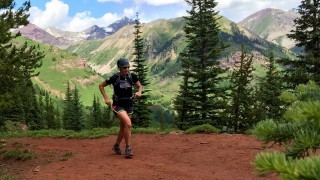
Photo: Shana Light
Our Trail of the Week feature is made possible through a partnership with Trail Run Project.
Teocalli Ridge is a classic run in the Brush Creek area outside Crested Butte. It’s the perfect option if you want a full value run, but weather may be too spotty for a longer day in the high peaks. The high point is right below treeline, and while it’s never good to get stuck in a thunderstorm, you are never too exposed on this route.
Once on West Brush Creek Road, the climb starts to get steeper. In approximately half-mile, you’ll come to another intersection, take a right here at the sign directing you toward the Teocalli Mountain Trail. Soak up the views in the next couple miles along the West Brush Creek drainage.
When the road ends, you’ll take a right to get on Teocalli Mountain Trail #554. This is where the climb gets tough, but that is offset by stunning Elk Mountain scenery. When you get near the top of the ridge you’ll take a right onto Teocalli Ridge #557.
After awhile you’ll come to a break in the trees with a nice view point and stopping area. Soak in great views of Teocalli Mountain, Castle Peak, Pearl Pass, and the Middle Brush Creek drainage on your left. If you are on the mellow train, this is a good place for lunch.
A couple of need-to-knows: First, there are two creek crossings. One on the way up the doubletrack before you get to Teocalli Mountain Trail, and the other the way out on Brush Creek Road. In early season (late May/June) these may be high due to snowmelt, so use caution.
Secondly, this is a popular bike trail, so be alert for fast moving mountain bikers coming up behind you on the ridge and final downhill. You might be moving faster than them on the big climb!
The Data
Miles: 11.5
Runnable: 86 percent
Singletrack: 60 percent
Average Grade: 7 percent
Max Grade: 33 percent
Total Ascent: 2,168 feet
Total Descent: -2,172 feet
Highest Elevation: 11,269 feet
For a closer look, check out the interactive map, data, photos and virtual run simulator courtesy of Trail Run Project:
The post Trail of the Week: Teocalli Ridge Loop, Colorado appeared first on Competitor.com.
5 Places to Run In…Washington, D.C.

Looming over the city, Capitol Hill is a common sight from several running paths in D.C. Photo: Shutterstock.com
Washington may be known for its political scene, but its running community is just as active. And thanks to a neat network of trails, paths and greenways throughout the greater D.C. area, there’s plenty of variety when it comes to where to run. “It’s rare to be in the heart of a city but still have lots of open green spaces for running,” says Emily Richard, an elite triathlete and D.C. resident. “I genuinely do think D.C. is a great runner’s city.”
Here are five top places to get in your mileage in-and-around the city:
Mount Vernon Trail
A quintessential D.C. run, this 18-mile path takes you along the Virginia side of the Potomac River from Theodore Roosevelt Island to George Washington’s Mount Vernon home. For a scenic out-and-back stretch, start at the Roosevelt Island parking lot then head south, passing under Roosevelt and Memorial bridges while iconic sites like the Jefferson Memorial and the Tidal Basin beckon from across the river. Make your turnaround point at the tip of Gravelly Point Park, where you’ll be awed by the site of low-flying planes seconds before they touch down at Reagan National Airport. Head back to your starting point to log just under a 10K, or tack on more mileage by cruising over Memorial Bridge and winding your way down to the National Mall for an epic running tour of the capital.
Rock Creek Park
The oldest and largest urban park in the national park system, Rock Creek Park is currently celebrating its quasquicentennial (that’s 125 years). And as any local runner who’s traversed the 32 miles of trails can tell you, a run in Rock Creek is always timeless. Away from the hustle and bustle of the city, you’ll get a welcome break in nature as you weave your way through the woods around Washington and Montgomery County, Md. Access the park at various points throughout the city—wherever you roam, your run will be as tranquil as they come.
MacArthur Boulevard
Lofted above the Potomac River along the border of Montgomery County and Washington, D.C., this mostly flat, paved route takes you into the city while offering plenty of scenic views along the way. Various entry points along the path allow you to venture down to the C&O Canal towpath for a change of venue. Or, take a whimsical detour into Glen Echo Park (7300 MacArthur Boulevard), established in the early 1900s, where you can check out the still-operating carousel. Carry on along MacArthur and you’ll eventually hit the Capital Crescent Trail (via the Little Falls Trail at Sagamore Road), which you can follow all the way into Georgetown.
National Arboretum
Attention flora and fauna fans: This run’s for you. A quick drive from Capitol Hill, the National Arboretum is a 446-acre “living museum.” In the spring and early summer, you’ll run by beautiful blooms, from daffodils to dogwoods. Fall brings the foliage, and in the cold months you’ll spot emerald–hued holly bushes. Mostly closed to traffic, you can safely circle around the Arboretum’s grounds while checking out other sites, like the freestanding Corinthian columns found on Ellipse Road, which were removed from the Capitol during a renovation. Charge up the 239-foot Mount Hamilton and spy upon the U.S. Capitol building, the Washington Monument, the National Cathedral and more. A view well worth the effort.
Anacostia Riverwalk
The Anacostia River has never been the shining star of D.C. destinations, but a major revitalization of the surrounding area is set to change its status. Case in point: The Anacostia Riverwalk, a 15-mile-long multi-use paved trail outlines both sides of the waterfront. Partially shaded, smooth, and typically less traveled than the trails along the Potomac, you can check out a different side of D.C. while cruising around the waterfront. Look out for fun features like a futuristic footbridge and the docked USS Barry battleship, both by the Washington Navy Yard. For a post-run treat, explore The Yards, a $2 billion redevelopment project marked by lofty condos and high-rises, dancing fountains, and scads of inviting restaurants and cafes.
RELATED: 5 Places to Run In…Dallas
RELATED: 5 Places to Run In…Minneapolis
The post 5 Places to Run In…Washington, D.C. appeared first on Competitor.com.
80-year-old Preps for His 15th Rock ‘n’ Roll Virginia Beach Half Marathon
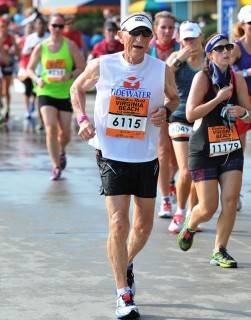
Photo: Courtesy of Rock 'n' Roll Marathon Series
Irreverently, they call themselves The Geezer Jocks. There’s the infant of the group, 66-year-old Rich Hildreth. There’s “the speedster,” a 67-year-old woman. There’s two guys in their 70s. Then there’s “The Colonel,” Chris Catoe.
Catoe is 80 years old and a retired Marine Corps colonel. The Geezer Jocks reside in or near Virginia Beach, Va., and Catoe coordinates the running group’s track workouts. If you think the track sessions might be nothing more than a couple 50-meter laps down the backstretch, check your ageist bias at the door.
On a recent morning, The Geezer Jocks ran two 200 meters, one 400-meter, four 800 meters, then laddered back down to another 400 and two 200s.
Catoe’s pace for the 800s: 4:15 to 4:30. To cool down, he jogs a lap between the 800 intervals.
Come Labor Day weekend, Catoe will run the Rock ‘n’ Roll Virginia Beach Half Marathon. The race is celebrating its 15th anniversary. Catoe has run them all, riding his bike to the start line.
“He’s one of the more remarkable individuals I’ve known,” says Hildreth. “He’s well-read. He’s got a sense of humor. He’s a genuinely good guy. I’ve been impressed with him for more than 10 years.”
Catoe entered the Marines after earning a business degree from George Washington University. Two of Catoe’s uncles served in the Marines during World War II. “I said if I’ve gotta go, I’m going in the Marines Corps,” he recalls.
At the Armed Forces Staff College (now called the Joint Forces Staff College), Catoe studied with Pete Dawkins, the 1958 Heisman Trophy winning running back out of West Point. Catoe and Dawkins soon took up weekly tennis matches.
“The first time we played, I thought, ‘Gee, I don’t think this guy has played tennis before,’” recalls Catoe, who played regularly. “After two or three times, he picked up the game. The last few matches I had a tough time staying with him. He was just a natural athlete.”
You don’t have to be a psychology major to understand why a Marine might morph into a successful marathoner—the discipline, attention to detail, etc. Interestingly, Catoe’s transformation into road racing began at the tail end of his 31-year military career.
He used to spend his lunch hour at a military base gym, saw a flier about a Virginia Beach 10K and the regulars were talking about running the race. Because his workouts were limited to 3 or 4 miles, Catoe had his doubts about stretching to 6.2. But he stepped to the starting line and survived.
That was 1986. He retired from the Marines in 1988. By 1989, he ran his first marathon. His debut 26.2-miler came in at 4 hours and 11 minutes. He would later PR at 3:28, fast enough to qualify for the 100th Boston Marathon.
He estimates his marathon count at 25. And half marathons? “Oh,” he says, “more than 100.”
Jogging provides Catoe with a community that values fitness as much as he does. It has also enabled him to keep his weight under control. Catoe said when he left the Marines he weighed 160-plus pounds. On his 5-foot-7-inch frame, he was in good shape.
“Even though we had pretty stringent requirements, we ate a lot of food,” he says of his military days. “If you didn’t work out you could get pretty porky.”
Today, the scale reads 146 pounds, 15 pounds lighter than when he retired. “I’m as light now as I’ve ever been,” he says.
At 80, Catoe runs 25 to 30 miles a week. His goals are modest now. His last marathon was in 2005 and he doesn’t plan to run another anytime soon. Half marathons stretch the far end of his comfort zone.
“I don’t have any grand plans to accomplish anything,” says the man who has accomplished so much. “I would like to keep running this Rock ‘n’ Roll as long as I can. That’s as much of any goal I’ve got.”
The post 80-year-old Preps for His 15th Rock ‘n’ Roll Virginia Beach Half Marathon appeared first on Competitor.com.
Skechers Performance Becomes Official Title Sponsor of Los Angeles Marathon
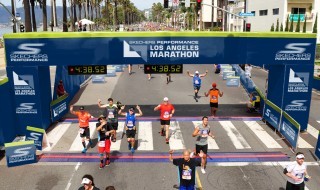
A mock-up of the new Skechers Performance Los Angeles Marathon finish line for next year's race. Photo: Courtesy of Skechers Performance
Skechers Performance, a division of Skechers USA, has signed a multi-year partnership with the Los Angeles Marathon, it was announced on Thursday. The event, formerly sponsored by ASICS, will officially be called the Skechers Performance Los Angeles Marathon. Under a new title sponsor, the 2016 race will be held on Feb. 14. Registration for it opens on Tuesday, Sept. 1.
“Partnering with the Los Angeles Marathon is a strategic step forward for our company and the Performance division,” Michael Greenberg, president of Skechers USA, said in a release. “As a Los Angeles-based business, we have always wanted to be a part of this iconic race since we began developing our performance footwear division and we could not be more thrilled to join the Los Angeles Marathon as title sponsor.”
The popular “Stadium to Sea” course starts at Dodger Stadium and finishes near the Santa Monica Pier. Skechers Performance will be providing finisher shirts and selling official merchandise at the Heath & Fitness Expo.
Skechers Performance-sponsored athlete and 2014 Boston Marathon champion Meb Keflezighi will also be competing in his namesake shoe—the Skechers GOmeb Speed 3—during the 2016 Olympic Trials Marathon in Los Angeles on Feb. 13, the day before the marathon.
For more info on the new partnership and race weekend, visit lamarathon.com.
The post Skechers Performance Becomes Official Title Sponsor of Los Angeles Marathon appeared first on Competitor.com.
Video: Usain Bolt Taken Out By A Cameraman On A Scooter
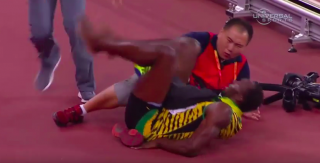
Just moments after defending his world title in the 200 meters, Usain Bolt was accidentally struck from behind by a cameraman on a motorized hands-free scooter, knocking him to the ground. The world’s fastest man appears have escaped unscathed and had a laugh while watching the replay. Phew!
The post Video: Usain Bolt Taken Out By A Cameraman On A Scooter appeared first on Competitor.com.
Photos: Men’s 800m Final and Women’s 1,500m Final
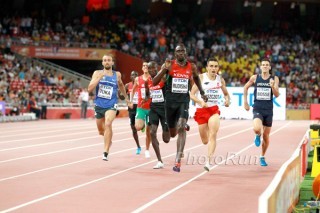
Ethiopian Genzebe Dibaba won the women’s 1500m final at the IAAF World Championships in 4:08.09 on Tuesday night in Beijing. She ran her final 800 meters in 1:56 and change to top Kenyan Faith Kipyegon and the Netherlands’ Sifan Hassan for gold. American Jenny Simpson lost her shoe midway through the race and finished 11th in 4:16.28. Shannon Rowbury of the U.S. was seventh in 4:12.39.
In the men’s 800m final, Kenyan David Rudisha continued his dominance of the event, winning in 1:45.84.
Check out these images of both events from PhotoRun.net.
RELATED: Dibaba Wins, Simpson Loses Shoe In Women’s 1500m Final
Photo Gallery
1 of {count}
Back to Start
View Larger Image

2015 World Outdoor Championships
An elated Dibaba celebrates her victory in the homestretch.
View Larger Image

2015 World Outdoor Championships
Dibaba was focused on the starting line.
View Larger Image

2015 World Outdoor Championships
Rudisha won a furious sprint to the finish over the final 100 meters.
View Larger Image

2015 World Outdoor Championships
"My shoe even ripped. I got spiked bad enough that it totally ripped when it came off. I was just unlucky," Simpson said.
View Larger Image
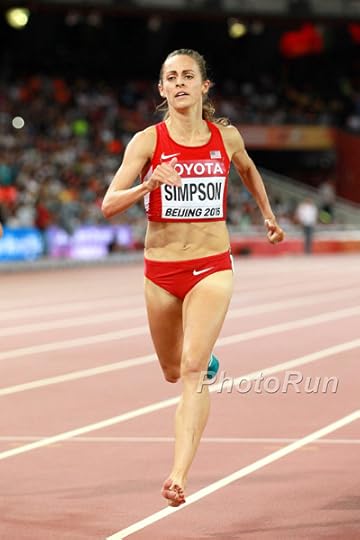
2015 World Outdoor Championships
Simpson finished in 4:12 despite losing her spike midway through the race.
View Larger Image
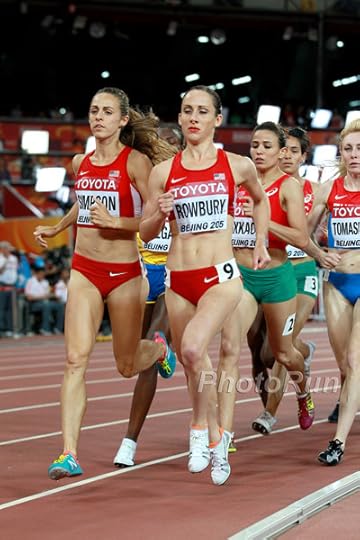
2015 World Outdoor Championships
Simpson and Rowbury took the field through a slow first 400 meters in 77 seconds.
View Larger Image

2015 IAAF World Championships
Dibaba ran her last 800 meters in a blistering 1:56.
View Larger Image
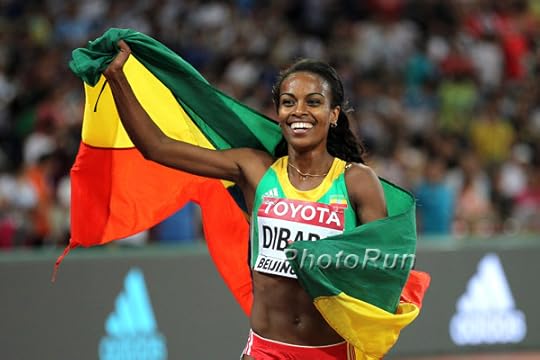
2015 IAAF World Championships
Dibaba has been untouchable this season over 1,500 and 5,000 meters.
View Larger Image
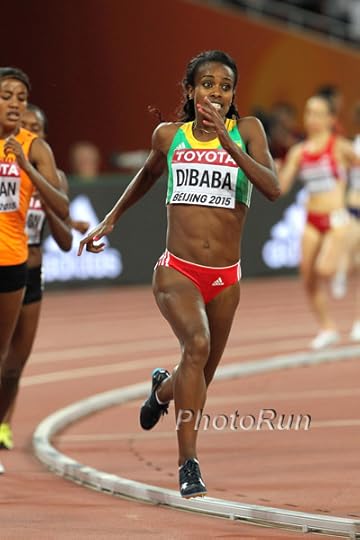
2015 IAAF World Championships
Dibaba blasted her penultimate 400 meters in 58 seconds.
View Larger Image

2015 IAAF World Championships
Rudisha and Rotich control the tightly bunched pack.
View Larger Image

2015 IAAF World Championships
Rowbury would finish seventh in the women's 1,500m final.
View Larger Image
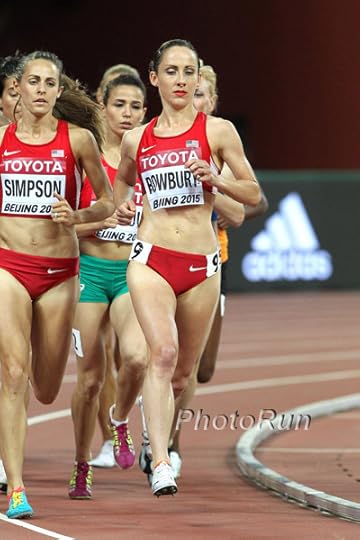
2015 IAAF World Championships
Rowbury and Simpson controlled the slow early pace.
View Larger Image
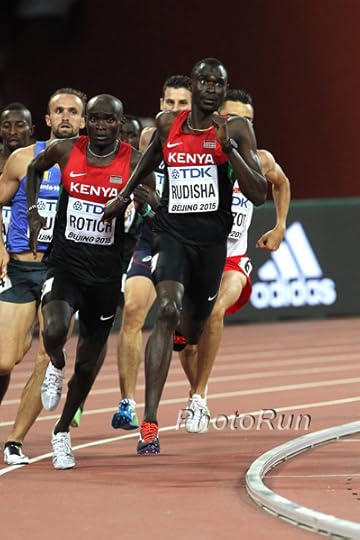
2015 IAAF World Championships
After a slow 54-secon first lap, Rudisha turned on the afterburners over the final 300 meters of the race.
View Larger Image
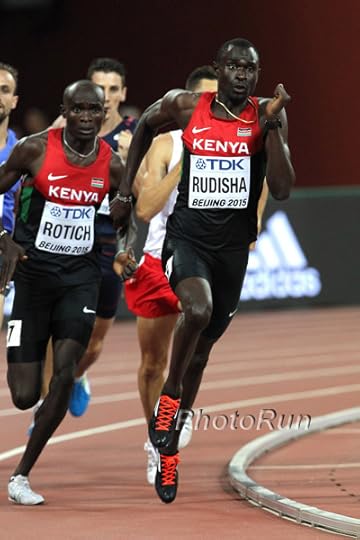
2015 IAAF World Championships
Rudisha begins his finishing sprint.
View Larger Image
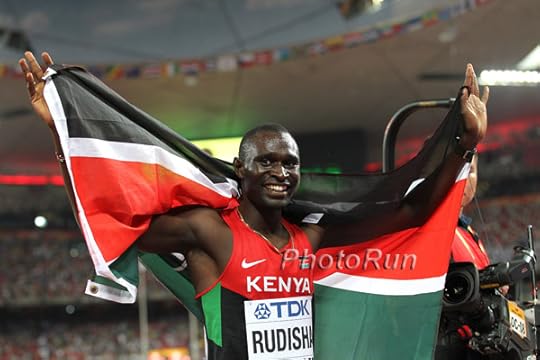
2015 IAAF World Championships
David Rudisha celebrates yet another world title.
View Larger Image
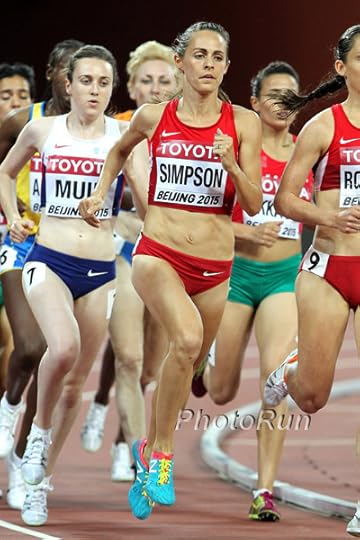
2015 IAAF World Championships
Jenny Simpson and Shannon Rowbury run in the pack.
Related Galleries

Photos: 2015 IAAF World Championships—Men’s Marathon
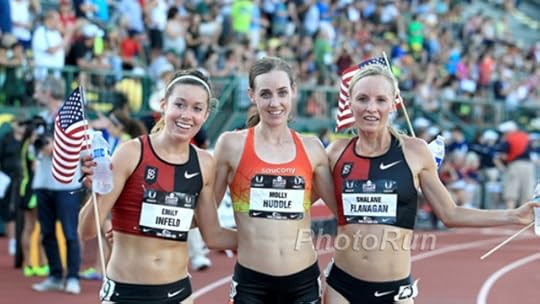
13 Great Storylines at the 2015 World Track & Field Championships
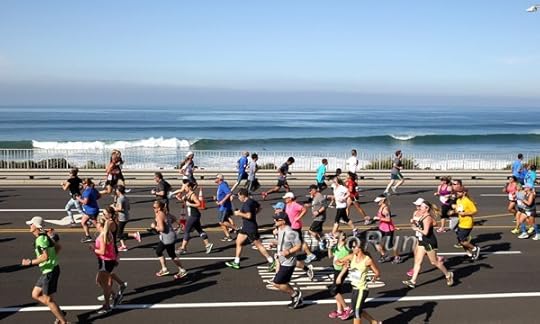
Photos: 2015 Carlsbad 5000
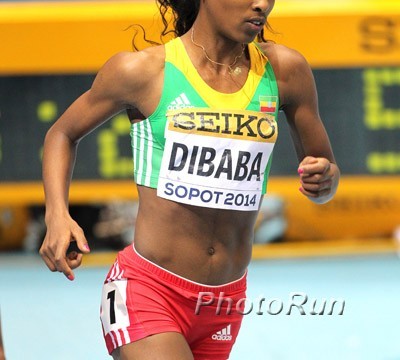
11 Women To Watch At The 2015 Carlsbad 5000

More Galleries
The post Photos: Men’s 800m Final and Women’s 1,500m Final appeared first on Competitor.com.
Tully Qualifies For World 5,000m Finals
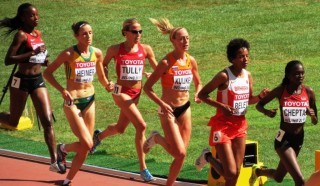
Nicole Tully on her way to qualifying for the 5000m final at the 2015 IAAF World Championships in Athletics. Photo: David Monti | Race Results Weekly
(c) 2015 Race Results Weekly, all rights reserved. Used with permission.
BEIJING—U.S. 5000m champion Nicole Tully looked downcast as she walked off of the track at National Stadium Thursday morning on the sixth day of the IAAF World Championships in Athletics. Tully, 28, had just finished eighth in her qualifying heat in 15:41.03, missing one of the top-five automatic qualifying places for Sunday’s final. She was now forced to wait until the conclusion of the second heat to see if she would get one of the five qualifying positions based on time. She was on the bubble, waiting for the lower case “q” to pop up next to her name on the results system.
Tully didn’t think she would be in this position. In only her third 5000m race, she appeared to be running comfortably, and was in the same pack as heat winner, Genzebe Dibaba of Ethiopia, through 3000 meters (9:21.60). She was only four seconds back at the 4K mark, but couldn’t handle the quick change in tempo in the final kilometer, falling well behind. She was hurting.
“It felt hard too soon, you know what I mean?” said Tully, who also works a full-time job in public relations for an electronics company. “When the string broke, I knew that was where I needed to be, but it was such a surge. I tried to tuck in, but I lost contact from three laps out. My arms were dead. My legs were dead.”
After stopping to speak with an official from USA Track & Field to give her official post-race quote, Tully leaned against the railing of the mixed zone to watch the second heat on a monitor. She analyzed every lap, every move to see if her time might hold up.
“If this heat goes stupid-slow, then I can still get in on time,” Tully said, looking at the monitor doubtfully. “I don’t know.”
Japan’s Ayuko Suzuki took the lead from the gun. She led the field through the first kilometer in 3:16.67, more than 11 seconds slower than Tully’s heat. There was hope.
“It just seems like a Japanese woman goes to the front and leads it every time,” Tully observed wryly.
Suzuki remained in the front through 2000m (6:17.24) and was just a step behind the leader, Ethiopia’s Almaz Ayana, at 3000m (9:17.23). But the pace was picking up. The leaders were now 3 seconds faster than Tully’s heat, and her hope began to fade. She grew more tense by the moment.
“It’s a nerve-wracking 20 minutes,” Tully told Race Results Weekly. “You know, there’s nothing you can do.”
But there was a big break in the field. Ayana was running laps of 71 seconds or faster, but the field had strung out and Tully began to count the women behind her, estimating how big the time gap was. Ayana won the heat easily in 15:09.40, much faster than Dibaba’s 15:20.82, but most of the other women were well behind. The fifth women, Eloise Wellings of Australia, came across in 15:26.67, the last of the automatic qualifiers, then came the rest: 15:28.18, 15:43.57, 15:48.52. She was in, the fourth of five time qualifiers.
“Wow,” Tully said, looking mildly stunned. “It feels good now. It didn’t feel so good when I finished my race, but I will say I was very nervous for this. I think I had that nervous energy. Now, I don’t have that for the final. It’s just run and have fun, and take a few days to recover.”
Tully will be the only American woman in the final. Her teammates, Marielle Hall and Abby D’Agostino, ran in the second heat, finishing 10th and 12th, respectively. Their times of 16:06.60 and 16:16.47 were well outside of the qualifying window.
“I’m so happy that even though I wanted to die I made myself stay in it knowing that I could still get in on time,” Tully said. “This was my first 5K that hurt for a long time, and mentally I think that was the hardest part. I didn’t give up.”
The post Tully Qualifies For World 5,000m Finals appeared first on Competitor.com.
August 26, 2015
Chicago Marathon Doing Away With Pacemakers
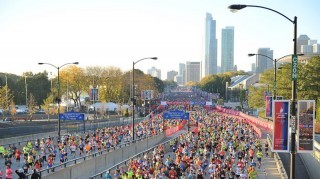
Photo: Bank of America Chicago Marathon
In somewhat of a surprise move, organizers of the Chicago Marathon announced on Wednesday that the prestigious race—one of six in the World Marathon Majors series—will do away with elite pace-makers beginning with this year’s edition on Oct. 11.
“We have always tried to blend pace and competition,” race director Carey Pinkowski told the Chicago Tribune. “But the athletes relied too much on the pace up front, and the chemistry of the competition has become too much about settling in behind the rabbits. Without the rabbits, the leaders need a much greater level of concentration. That will allow us to see more tactics, strategy and competition throughout the race.”
Chicago, which has used pacemakers since 1990, is known for its flat course profile, deep elite fields and traditionally fast times. It joins both the Boston and New York City marathons as rabbit-free races in the WMM series, which awards an annual $500,000 prize to its male and female winners. The other three WMM events—London, Berlin and Tokyo—will continue to employ pace-makers to chase world and course-record times. Should a runner break a course or world-record in Chicago, they will still be awarded an additional prize bonus for their efforts.
“This is a place where people always have come to run fast,” Pinkowski told the Tribune. “Great competition produces great performances.”
MORE: Chicago Tribune
The post Chicago Marathon Doing Away With Pacemakers appeared first on Competitor.com.
Jepkemoi Takes Women’s Steeplechase Title at Worlds
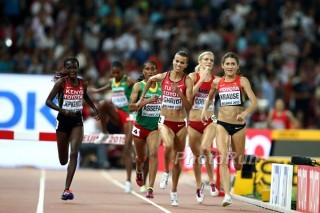
It was a tight finish coming off the last barrier in the women's steeplechase final. Photo: PhotoRun.net
(c) 2015 Race Results Weekly, all rights reserved. Used with permission.
BEIJING—Kenya increased their lead in the medal table here tonight to 11 (six gold) when in a period of just 90 minutes Julius Kipyego and Hyvin Kiyeng Jepkemoi won the men’s javelin and women’s steeplechase, respectively. It was the second consecutive edition of these championships where a Kenyan woman won the steeplechase title. Another Kenyan, Ezekiel Kemboi, won his fourth straight steeplechase title on the men’s side two days a go.
While Kipyego overwhelmed the field with a massive 92.72 meter toss—the second longest in the history of these championships—Jepkemoi squeaked out her win by a fraction of a second in 9:19.11 over two strong rivals, Tunisia’s Habiba Ghribi and Germany’s Gesa Krause, in a tactical race. The three medalists finished in a span of just 9/100ths of a second.
“At the finishing,” she answered when asked when she knew she had won the race. “Because we were three.”
RELATED: Three American Men Advance To World 5000m Finals
Those three were part of a tight pack of five heading into the race’s final water jump. Team USA’s Emma Coburn was among them.
“A lot of girls going in and taking different angles to get out,” Coburn said about the final water jump. “I was on the inside line and ended up getting cut-off.”
Coburn was two steps behind rounding the final bend, and in just a few seconds was out of contention for a medal. Ethiopia’s Sofia Assefa, the bronze medalist from these championships in 2013, couldn’t hang on to the leading three as they fought for the best position coming into the final barrier. She had to settle for fourth.
Ghribi, who is one of the best hurdlers in the sport, stutter-stepped several times ahead of the barrier, losing her momentum. At the same time, Jepkemoi was pouring it on, and hurdled the barrier at full speed. She was third over the barrier, but was still accelerating.
“I think it was very fast,” Jepkemoi said of the final lap. “The last 400 was not so easy. But, I think the last barrier is where I put my whole effort. When I finished the barrier, I had all my energy.”
Running in Lane 2, Ghribi’s form broke down in the final sprint, while Jepkemoi strode smoothly to the line on the outside. Krause, on the inside, battled to get the silver, and would finish just 1/100th of a second behind Ghribi, getting the bronze in 9:19.25. She could barely believe that she medaled.
“I dreamed about it, but I think I never imagined it,” she told Race Results Weekly. “That’s a scenario which is happening in my dreams, so it’s kind of motivating me for hard sessions. But, I actually never thought it will happen at this point.”
Ghribi, who was the silver medalist at both the 2011 World Championships and 2012 Olympics, had to settle for silver again. She was not happy with how the race played out.
“Nobody wanted to run,” she lamented about the slow opening laps. “I wanted to finish fast as usual but, unfortunately, everyone was there and I was a bit disturbed. I tried to win the final sprint, but the Kenyan was faster, unfortunately.”
Coburn, who matched the place of her training partner Jenny Simpson who finished fifth in these championships in 2009 in Berlin, was also disappointed. Although she had set a goal for top-5, she felt in the last lap that she could have medaled, but lost too much momentum when she got cut off coming out of the final water jump.
“I’m really disappointed right now. I’m not going to cry. I’m not going to beat myself up. I feel like I did everything I could. I really thought, I really thought that with 250 to go I was in contention for a medal. It’s a hard pill to swallow when it doesn’t go your way.”
The victories for Kipyego and Jepkemoi were overshadowed, however, by news from the IAAF that two Kenyan athletes, Koki Manunga and Joyce Zakary, had tested positive for a banned substance and had accepted provisional suspensions. Manunga had finished sixth in her heat of the 400m hurdles, while Zakary had set a national record of 50.71 in the first round of the 400m. She did not start in the semifinals.
The post Jepkemoi Takes Women’s Steeplechase Title at Worlds appeared first on Competitor.com.
Shoe of the Week: Hoka One One Speedgoat
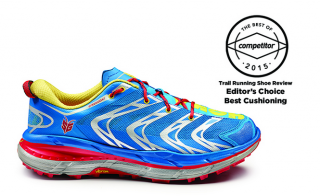
The Speedgoat has maximal cushioning and a moderately sticky rubber outsole.
Fit-feel-ride: Although this shoe is technically the third version of the Rapa Nui model (it was renamed Speedgoat in honor of Hoka runner Karl Meltzer), it’s really a completely revamped shoe with a narrower fit, more aggressive outsole and a softer midsole. No matter what you call it, the Speedgoat is the most aggressively lugged Hoka trail running shoe to date. The Vibram rubber traction does a great job of gripping onto everything from steep and rocky terrain to loose dirt. The hard rubber tooth-like outsole means this isn’t the best choice for runs on partial road or all-mellow trails, but for mountainous adventures, we appreciated the sure-footedness. This is a very smooth-running shoe—the massive foam midsole provides ample cushioning that’s forgiving on joints without compromising control. The upper feels burly and has a solid toe bumper for added protection, hence this shoe’s ability to charge in rugged terrain. A few testers found this shoe to feel a bit stiff at first; it takes some breaking in before the upper feels soft and conforming.
This shoe is for you if … You’re a Hoka devotee (or want to be), like soft cushioning and run technical terrain of any sort.
Price: $130
Weights: 9.7 oz. (men), 8.6 oz. (women)
Heel-toe Offset: 5mm; 33mm (heel), 28mm (forefoot) for men; 31mm (heel) 26mm (forefoot) for women
Info: Hoka One One
RELATED: Shoe of the Week—Nike Air Zoom Wildhorse 3
The post Shoe of the Week: Hoka One One Speedgoat appeared first on Competitor.com.
Ryan Hall's Blog
- Ryan Hall's profile
- 21 followers



